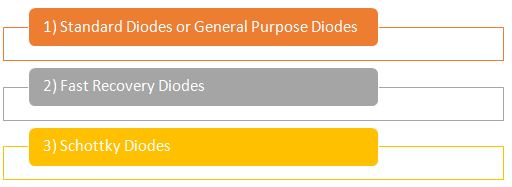In the previous article, we ended up discussing the reality gap between ideal diodes and real diodes. We came to know that ideally we suppose the reverse or leakage current in a diode to be zero. Now check an article about the different types of diodes.
You too can send your articles or tutorials, debates, product reviews, etc. Just send us a mail.
Introduction
The diode totally stops any leakage current never considering any breakage of the junction barrier. But since things are not ideal in this world, we do face some problems considering non ideal behavior regarding the reverse leakage current in the diodes.
So to adjust this, we associate a reverse recovery time with each diode, which marks the time required for the diode to recover from the reverse current.
But the reverse recovery time acts as a bargain with the diode cost. A diode requiring lesser reverse recovery time will be more expensive than a simple diode with a larger reverse recovery time.
Choice of a Diode
Now the question that arises is that how do we decide if we want a cheaper diode or a diode with a comparatively larger reverse recovery time. So the answer to it is that this choice depends upon your application.
- In many applications, the effects of a reverse recovery time are not significant. It does not matter that much or cause delay or any sort of damage. Due to this reason inexpensive diodes can be easily used there, and consequently your money can be saved.
- On the other hand some applications are sensitive and thus require a diode which shows near to ideal behavior. For this purpose one should compensate money to achieve the best results.
The following graph shows the reverse recovery characteristics of a diode:
Major Classification of Diodes
So depending on the reverse recovery characteristics of the diode and their manufacturing techniques, power diodes are classified into three major categories which are as follows:
- Standard Diodes or General Purpose Diodes:
- Fast Recovery Diodes:
- Schottky Diodes:
Standard or general purpose diodes have a comparatively high reverse recovery time, when compared to other diodes. Due to this reason they are used in applications which are not time sensitive and generally run on low speeds.
Usually the reverse recovery time for general purpose diodes varies between 20 micro seconds to 30 micro seconds which is quite a lot. Typical low speed applications for general purpose diodes include the power diode being used as a rectifier or in a converter, where the frequency input is quite low.
As their name suggests, these are the type of power diodes which have a relatively faster reverse recovery time, which usually varies from 2 micro seconds to 5 micro seconds. With such a fast recovery time, they can be easily used in high speed switching applications where the time is of great importance.
Due to their property of fast reverse recovery, they are also comparatively expensive as compared to the general purpose diodes.
Sometimes we face problem in charge storage in a pn-junction. This thing can be minimized to a great extent in a Schottky diode. A Schottky diode sets a barrier potential, i.e. a metal layer is deposited on n-type silicon.
As the rectification depends upon the majority charge carriers, so this layer prevents the recombination of these majority charge carriers, and a fast recovery can also be achieved in this way.
Conclusion
These were some of the basic types of Semiconductor power diodes and the basis on which they are classified. They were discussed briefly just so you can be able to make a choice on which type of diode you need to select for your application.
In the next article of this tutorial I am going to explain the connections of the diodes. So stay tuned and keep getting updated on Semiconductor Power switching devices!
Nasir.

